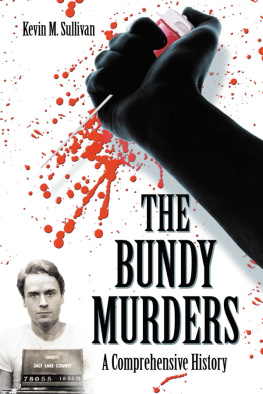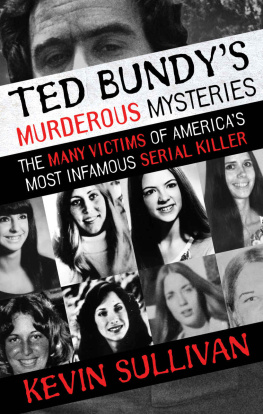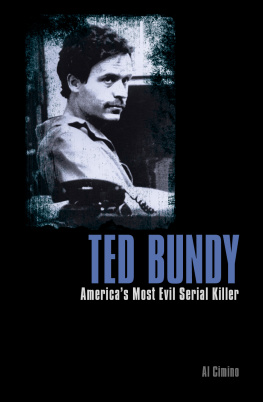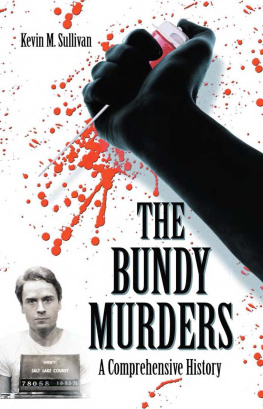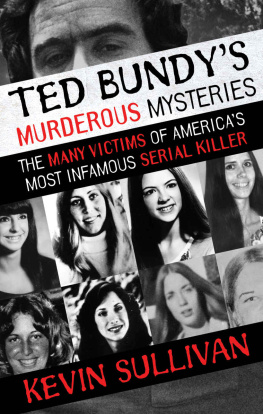

WildBluePress.com
The Trail of Ted Bundy published by:
WILDBLUE PRESS
1153 Bergen Pkwy Ste I #114
Evergreen, Colorado 80439
Copyright 2016 by Kevin Sullivan
All rights reserved. No part of this book may be reproduced in any form or by any means without the prior written consent of the Publisher, excepting brief quotes used in reviews.
WILDBLUE PRESS is registered at the U.S. Patent and Trademark Offices.
978-1-942266-37-2 Trade Paperback ISBN
978-1-942266-38-9 eBook ISBN
Book Cover and Interior Formatting by Elijah Toten
www.totencreative.com
Table of Contents
For the Victims
Both the Living and the Dead
Preface
I n 2009, my book The Bundy Murders: A Comprehensive History was published by McFarland & Company. Its an in-depth biography of the infamous serial sex killer Ted Bundy. Published 20 years after Bundy was put to death, it was the first biography of the killer to be published in many years. The book contains new information about the case, sheds new light on a number of the murders, and it continues to be well received by those fascinated by Bundys reign of terror.
Bundy, who became a successful killer through meticulous planning and execution of his crimes, operated in at least seven states, and during his years of murder 1974 through most of 1975, and then again in 1978--managed to kill more than 30 women. Indeed, that number may be higher, and may in fact exceed 50, as there were murders Bundy refused to talk about. His victims were mostly young women, but he murdered teenage and preteen girls as well, and these younger victims he did not like to talk about.
Bundys method of killing was mostly consistent, although he could deviate from his norm at any moment. Many women were whacked on the head with a crowbar, and almost all were finished off through strangulation while Bundy had sex with them from behind. Necrophilia in various forms was usually a part of the murders, too, especially if Bundy had the time to spend with them after they died or if he was able to return to the remains at a later date. This, of course, was not always possible. One of the most bizarre aspects of this sexual deviance is that while living in Washington (where the murders began), Bundy kept as many as four womens heads in his apartment at a rooming house where he was living. That he used these heads for sexual pleasure, there is little doubt.
So this retrospective looka back story if you will, into the life of Americas most diabolical serial killer--will not be another biography. Rather, its a deeper look into his crimes across various states containing new and interesting information about the case; a case that to this day still has a sense of mystery surrounding it. It is, in fact, a search for additional truth and, as such, is an excellent companion volume to The Bundy Murders .
Within these pages youll read new testimony from those who knew the killer, from friends of the victims, and from others who were involved in this story one way or another. Indeed, this book records for history many important voices that would otherwise go silent after the passage of time. In my view, to not add these voices to the record would be a crime.
It also includes new and previously unpublished stories from some of Bundys Mormon friends, whom the killer met after he moved to Utah to attend law school. He sought out their friendship, proclaiming an interest in the Church of Jesus Christ of Latter-day Saints. They, of course, welcomed him with open arms, believing him to be a good and honest man. But like those who knew Bundy in his home state of Washington, they would later be shocked to learn of Bundys true inner drives and intentions. Bundys monstrous desires and cravings to kill and mutilate women were not easy for many of his friends to believe, and some would not accept that these dark accusations against him were true until the end, when Bundy finally started to come clean.
I must also note that the bulk of the testimony youll be reading in this book (new interviews and the written record) comes from people from Washington and Utah, as these are the two states where Ted Bundy put down roots and developed relationships with many people. But I have new interviews and testimony as well from California, Oregon, Idaho, and Colorado, as well as additional material that will enlighten the reader with facts usually seen only by those conducting in-depth archival research into the Bundy case.
On top of all this I have also taken a closer look at some of the murders, their locations, and some oddities and new discoveries that werent in the first book, and there are photographs of all of those sites. It will, without a doubt, be a most fascinating excursion into Ted Bundy and his unequaled time of terror.
A personal note: When I finished The Bundy Murders , at 5:21 a.m., July 17, 2008 (yes, I wrote it down), I was exhausted emotionally and physically from my 2-year marathon into the life of Ted Bundy. By the time I typed that last word, I felt like I knew the killer better than some members of my own extended family. I also discovered along the way (and in the years since) that the victims became a part of my life. There isnt a day that goes by that I dont think about them and the man who took their lives. Not to sound overly dramatic, but it is as if the case has been indelibly printed deep within the recesses of my being, and for the rest of my life it will be there. And frankly, thats fine with me. It goes with the territory.
Once the book was published, I was more than willing to answer questions about the case, and I even knocked out the occasional article. But the thought of writing another book where the focus would be Ted Bundy? Not a chance! That was out. I couldnt imagine delving into that dark world once again. So when a writer asked me a couple of years ago to co-author a book about the killer, where wed be exploring possible new aspects of the case, I politely said no. And then, in the spring of 2015, I spoke with someone closely connected to the investigation, and discovered they were having significant medical problems. Understanding that time waits for no one (its been 41 years since Bundy began his murderous career), I knew it was time to seek out people and consult the case files one more time. We owe it to future generations to record now those voices still out there who are willing to talk.
The result of that decision is the book youre about to read.
Louisville, Kentucky
Fall 2015
Chapter One
The Washington Murders
O n December 20, 1974, Black Christmas , a Canadian slasher film, was released (for perhaps a somewhat limited release) in the United States. It was based on a series of murders that occurred in Montreal, and the movie depicts the killing off one by one of a houseful of sorority sisters. Of course, its unknown if Ted Bundy ever saw this film, and by Christmastime in 1974, hed been murdering women for almost a year. But it is known that Bundy later told authorities it might behoove them to stake out theaters showing slasher films when theyre looking for killers. Bundy, who knew quite a bit about avoiding detection, was no doubt on to something.
Without question, Bundys impact on the state of Washington was the most horrific and psychologically altering reign of terror in collective memory. Beginning in January 1974 until the killer silently slipped out of the state that September, the region was subjected to the ongoing strange disappearances of college-aged women. Before he moved on to another killing ground, Bundy would murder at least eleven women, all within a span of eight months.





